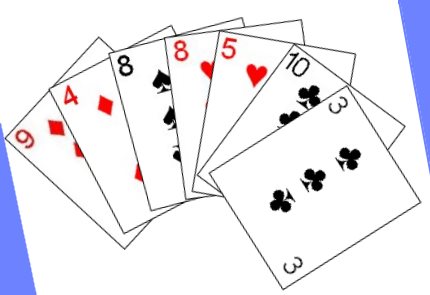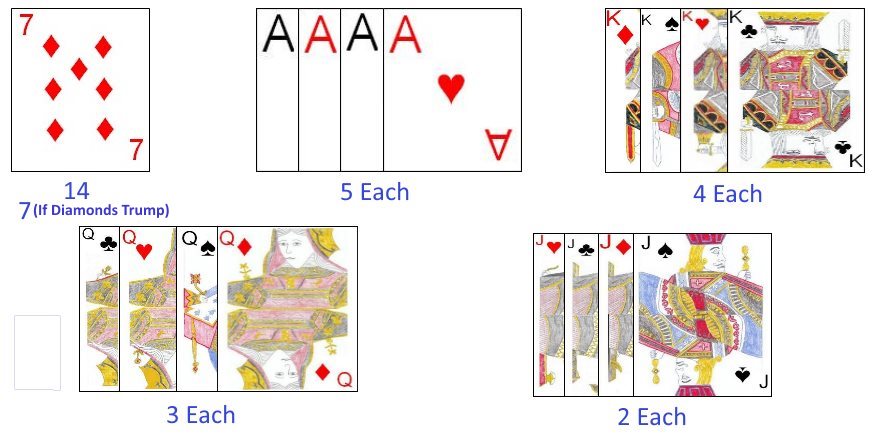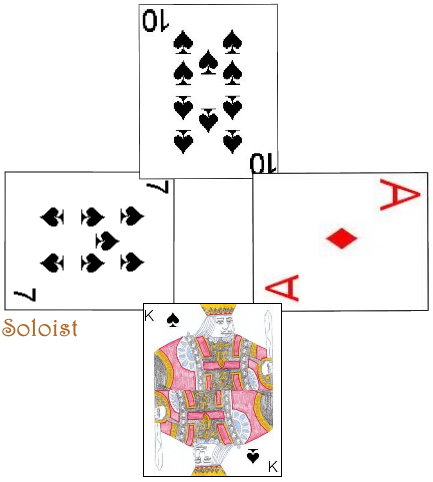Penneech is a card game which appears to have been lost to history. It was one of the games included in Charles Cotton's publication
The Compleat Gamester, second edition, from 1676.
Penneech is a trick taking game bearing some resemblance to All Fours and other similar games. What makes the game quite unique is that the trump suit changes for each trick. The game is designed to be played by two players and uses one standard 52 card deck. The ranking of the cards used in this game is dependent somewhat on the
specific suit. In the suits of Clubs, Spades, and Hearts the ranking of the cards is as follows (from high to low); Ace, King, Queen, Jack, 10, 9, 8, 7, 6, 5, 4, 3, 2. In the suit of Diamonds, the ranking is slightly different, as follows (also from high to low); 7, Ace, King, Queen, Jack, 10, 9, 8, 6, 5, 4, 3, 2.

|
| A hand consisting of
no card higher than a 10 is eligible for request of a redeal |
Determination of the first dealer can be performed using a variety of methods, with draw of a low card a common method. Although the Ace is considered a high card, for purposes of this draw, the Ace is considered the lowest ranked card
in the deck. For each hand thereafter, the role of the dealer alternates amongst the two players. Once the first dealer has been determined, he should then deal out seven cards to each player starting with his opponent. He deals the cards out one-at-a-time and face down
in a clockwise direction. After each player has the requisite number of cards, the dealer places the remainder of the pack face down in a stack on the table. If either player receives a hand that contains no card ranking higher than a 10, he may (but is not obligated to) request a new hand. In doing so, he simply exposes the entire hand. He may only do this before play of the hand begins, however.
The game is played in a series of seven tricks with each player contributing one card from the hand to each trick. The non-dealer leads the first card to the trick, and for each trick thereafter, the winner of each trick leads the first card to the next.
Trump Turn-Up: Before each trick, including the first, the top card of the face-down stock is turned over to expose it's current top card. The suit of this card sets the trump suit for this next trick. On the first hand this turn-up is performed by the dealer, and for each trick thereafter, the winner of the trick exposes the next card to set the trump for the next trick. In addition, if this card is any Honour, the player who turned-up the card immediately scores a number of points based on the Honour card exposed.
When playing to a trick led by the opponent, if a player has a card of the suit originally led, he must play a card of that suit or a card from the current trump suit. If a player does not have a card of the same suit as led to the trick he may play any other card remaining in his hand (including of the trump suit). The highest card of the trump suit played to the trick wins the trick. If the trick contains no cards of the trump suit, the winner of the trick is the player of the highest card of the suit originally led to the trick. After winning a trick, the winner scores for any Honours contained in the trick, sets the cards from this trick aside (no longer used in the current hand) turns the previous trump card face-down and exposes the next card from the stock. After the last of the seven tricks is won, the winner of that last trick, turns over one more card from the stock, scoring if the card is any Honour.
As mentioned, the main method to score points in this game is by winning Honours in a trick or turning an Honour up from the stock. The following chart shows the specific Honour cards and the point value for winning the card in a trick or turning it from the stock:
| Honour Card | Points When Won in a Trick | Points When Turned from Stock |
|---|
| Seven of Diamonds (Penneech) | 7 if Diamonds are Trump - Otherwise 0 | 14 |
| Any Ace | 5 | 5 |
| Any King | 4 | 4 |
| Any Queen | 3 | 3 |
| Any Jack | 2 | 2 |
|
|
 |
After all the tricks have been played and won, the player who won the majority of the tricks earns one point for each card in excess of 7 they won in tricks during the hand.
The first player to score a total of 61 or higher during the game is declared the winner. Since the scoring is continuous during the hand and occurs frequently, a Cribbage board is usually used to record the score, with players pegging each score on the board as made.
Piquesept: Piquesept is another old game from near the same time period as Penneech and appears, at least superficially, to be related to that game. Although somewhat newer than Penneech, Piquesept is
also currently not known to have any active players. This game was found mentioned in
certain antique literature, including a set of rules for the game published in 1798.
The game is usually played by four players in an unusual format, with one player playing solo against the other three. The game is played using the 32 card piquet deck. In this deck the suit of Spades is always considered the trump suit. In this permanent trump suit, the ranking of the cards is as follows (listed from highest to lowest): 7, Ace, King, Queen, Jack, 10, 9, 8. In the other three suits (Clubs, Hearts and Diamonds), the ranking is only slightly different (also from highest to lowest): Ace, King, Queen, Jack, 10, 9, 8, 7.

Determination of seating positions and first dealer can be performed in a variety of methods, with draw for high cards a suggested method. Using this method each player draws a card from the shuffled deck. Players then take seats in the order of cards drawn. Cards in the trump suit (Spades) automatically outrank cards from other suits. If players draw other cards of the same denomination, they should discard and redraw until drawing cards of unique denominations. Players then take seats in the order of cards draw, highest to lowest, with the player drawing the highest card of all set as the first dealer. After each game, the role of dealer rotates around the table in a clockwise direction.
After the players are seated and the first dealer determined, the dealer should then thorougnly shuffle the cards and offer the pack to the player at his immediate right to cut. After the cut, the dealer then begins dealing the cards, one-by-one and face down in a clockwise direction around the table, starting with the player to his immediate left. He continues dealing until the entire deck has been fully dealt, with each player receiving eight total cards.
Whichever player has been dealt the seven of Spades (the highest card
in the deck) is set as the soloist against the three other players (the
defenders). Thus, to start the game, the player who has received this
card in the deal begins play by playing this card first to the center of
the table. Each other player in a clockwise direction must then play the
highest trump card in his hand to the trick. If the player has no cards
of the trump suit he must play the highest card he has in hand, from
whatever suit it might be. After each player has played one card to the trick in turn, the trick is set aside, face-down, won by the player of the seven of Spades. After this trick has been played and won, the player to the immediate left of the soloist draws a card randomly from the hand of the soloist and then gives the soloist back any card of choice from his hand, which may be the same card he drew. After this draw and trade of a card, the play continues as in most other trick-taking games.
The winner of each trick (including this first one) then leads the first card to start the next trick, leading any card of choice from his hand. Each other player in a clockwise direction then plays one card from his own hand to the trick. The rules for playing to an existing trick are somewhat different for the soloist and the other players. The Soloist is never required to follow suit to a trick and may play any card of his choice to each trick. However, the opponents of the Soloist must follow different rules as follows.
- If this player has a card of the suit originally led to the trick he must play such a card.
- If that player has no cards of the suit originally led to the trick he must play a card of the trump suit if he has one.
- Finally, if he has no cards of the suit originally led to the trick and no cards of the trump suit, he may play any card from his hand to the trick.
The player of the highest trump card to the trick wins the trick if it contains any cards in that suit. If the trick contans no cards of the trump suit, the player of the highest card in the suit originally led to the trick wins it. The cards won in each trick are set aside face down in a pile near the winner of the trick. The winner of each trick leads the first card to the next.
After all tricks have been played and won, the soloist counts his total in card points captured in tricks. All opponents of the soloist combine all cards won in tricks and also calcualte the number of points capture by all these opponents. Most of the cards in the deck have a scoring value as captured in tricks, as follows:
| Card | Card Point Value |
|---|
| Ace | 11 Each |
| Seven of Spades | 10 |
| Ten | 10 Each |
| King | 4 Each |
| Queen | 3 Each |
| Jack | 2 Each |
| All Other Cards | 0 |
Whichever team (the team consisting of the Soloist, or the team consisting
of the three Defenders) manages to score a total of 66 or more card
points during the hand is declared the winner.
Each hand is considered one complete game, and thus the players start with a score of 0 at the end of each game.
Copyright © 2015 CatsAtCards.com. All rights reserved.


 Determination of seating positions and first dealer can be performed in a variety of methods, with draw for high cards a suggested method. Using this method each player draws a card from the shuffled deck. Players then take seats in the order of cards drawn. Cards in the trump suit (Spades) automatically outrank cards from other suits. If players draw other cards of the same denomination, they should discard and redraw until drawing cards of unique denominations. Players then take seats in the order of cards draw, highest to lowest, with the player drawing the highest card of all set as the first dealer. After each game, the role of dealer rotates around the table in a clockwise direction.
Determination of seating positions and first dealer can be performed in a variety of methods, with draw for high cards a suggested method. Using this method each player draws a card from the shuffled deck. Players then take seats in the order of cards drawn. Cards in the trump suit (Spades) automatically outrank cards from other suits. If players draw other cards of the same denomination, they should discard and redraw until drawing cards of unique denominations. Players then take seats in the order of cards draw, highest to lowest, with the player drawing the highest card of all set as the first dealer. After each game, the role of dealer rotates around the table in a clockwise direction.